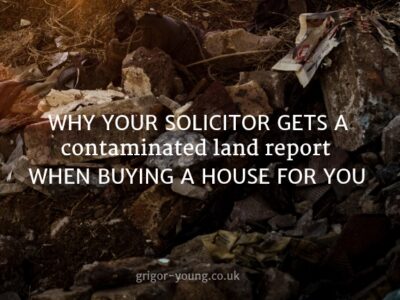Every year in the UK, we dump about 50 million tonnes of waste in the ground. This would be enough to fill a football stadium like Hampden Park to the brim – 50 times over!
A landfill site at Dunbar in East Lothian takes much of Edinburgh’s rubbish and it has won awards for its high standards. Regulations require the use of barrier layers – such as plastic, clay and soil – to ensure safe storage of the waste. The risk of leaks of toxic fluids and gases has to be managed for generations to come.
The manager at Dunbar is a local man. He has a vested interest in maintaining standards for the benefit of his community. The staff maintain clear records of what has been buried and where. It’s information which will be essential for the council planning departments of the future – when, say, they have to decide if a proposed building development should go ahead on the affected land.
The problem is that security of storage and record-keeping was not always this way.
In the past, considerations like the environment – and even public health – were left out of account when deciding whether a big hole in the ground was a suitable place for a landfill site. The modern regulatory system only came into force as recently as the 1990s.
There are reckoned to be about 20,000 historic landfill sites in the UK. Many of these are near coasts or rivers. As many as 2,000 sites are at risk from flooding or erosion.
The toxic materials which can leech into the environment include lead and mercury, previously widely used in household batteries. This can generate dangerous gases such as Hydrogen Sulphide and Hydrogen Cyanide.
In Moray, two examples of historic coastal landfills are at Hopeman and Lossiemouth.
When buying a house in Moray, your solicitor will ask the selling agent to provide a contaminated land report.
Generally, this comes from one of the Property Searchers and it will concentrate on the house you are buying.
The report will provide details of all sorts of possible sources of contamination, ranging from infilled quarries to former woodworking yards. Quarries were used as unofficial dumps for years before the advent of environmental legislation and wood working yards used highly toxic chemicals in the treatment of wood.
An old, disused petrol filling garage will even be highlighted.
Basically, these reports are desktop surveys which use old Ordnance Survey maps and other public data to produce a detailed 20-page report on the land surrounding the house you are hoping to buy.
Luckily, most of those reports come back with a big “Passed” splashed over the opening page.
If, however, you are one of the few unlucky ones where the report requires further investigation, then all is not lost.
Your solicitor has a number of avenues to go down. They will investigate the issues and – with help, often from the Council or the developer – more light will be shed on the problems and hopefully the issue will be resolved.
Moray is one of the few areas in Scotland where your solicitor will insist on a Contaminated Land Report when buying.
Solicitors from other areas will often try to resist paying for such a report.
In these cases, if the seller still refuses to pay for a report, your solicitor will recommend that, for peace of mind, you should obtain one at your own expense. The cost is approximately £44 and it is an expense well worth incurring.
If you want to know more about the severity of the problems which can occur, there is a fairly harrowing account of what can go wrong in the BBC Radio 4 documentary “What Lies Beneath: The Legacy of Landfill”, which is available to download as audio. The first part of this article draws on information contained in the documentary.
How we can help
If you have any questions arising from the terms of this article, please feel free to get in touch. All initial enquiries are free of charge and without obligation. You can call one of our Property team on 01343 544077 or send us a Free Online Enquiry.


 How Best to Protect Yourself Against the Risk of Developing Alzheimer’s
How Best to Protect Yourself Against the Risk of Developing Alzheimer’s